The Blue Stain: A Novel of a Racial Outcast by Hugo Bettauer (review)
Journal of Austrian Studies
Volume 51, Number 2, Summer 2018
pages 99-101
DOI: 10.1353/oas.2018.0027
Adam J. Toth, Lecturer of German
University of North Carolina, Wilmington
Hugo Bettauer, The Blue Stain: A Novel of a Racial Outcast. Edited by Peter Höyng. Translated by Peter Höyng and Chauncey J. Mellor. Rochester, NY: Camden House, 2017. 144 pp.
Hugo Bettauer, an author virtually unknown to the U.S., will see new appreciation with the recent translation of his novel The Blue Stain: A Novel of a Racial Outcast. Originally titled Das blaue Mal: Der Roman eines Ausgestoßenen and published in 1922, Peter Höyng and Chauncey J. Mellor’s new and first translation of this book will make it more accessible to audiences in the English speaking-world. The translation of this novel arrives at a critical and relevant time particularly in the U.S., as the novel tells the story a half-white/half-black protagonist of Austrian and African-American descent and his life in various parts of the United States and Vienna. The novel offers crisp perspective during the U.S.’s ever-present crisis of racism and social injustice. Rather than nitpicking and fussing over the details of the translation, however, I will focus on the translators’ note, the introduction, and the afterword, as these matter a great deal to those gaining access to Austrian literature without the benefit of the German language under their belt and therefore weigh heavily on the work’s overall success.
Höyng and Mellor’s notes on the translation process accurately explain how they rendered the novel into English but offer limited perspective behind some of their decisions. When explaining how to translate the interjection “Wehe,” Höyng and Mellor assert that “possible dictionary translations for ‘Wehe’ were ‘alack‘ and ‘woe is me,’ both of which sounded hopelessly stilted and obsolete, reminiscent of shallow melodrama, and out of character for Zeller. ‘Good grief‘ was also rejected, because it evokes Charlie Brown’s use of this stock phrase in Peanuts and the bemusement it conjures up. ‘Good Gracious‘ showed up, but seemed a bit too pretentious, British, and possibly effeminate” (Höyng and Mellor, ix). For whom “Good Gracious” may seem pretentious, how the expression may seem too British, and why it would sound too effeminate (or effeminate at all) remain unanswered. While I can appreciate any amount of constraints the translators may have had in writing their notes, their target audience seems to only be one that speaks English but not German. Dwelling on such Kleinigkeiten in their introduction diverts the reader’s attention away from the text as a whole and down a rabbit hole on semantics and approximation. That said, the careful attention Höyng and Mellor gave to the work’s title and the translation of pejorative language against African-Americans in the original and in the translation express the importance of the novel itself and could itself hardly be considered trivial.
Höyng’s introduction gives the most thorough contextualization of the novel possible, guiding its readers through Bettauer’s known biography and the historical milieus of the book and its author. Höyng notes that “The Blue Stain represents the first novel in German to address racism in the United States in the twentieth century” (xv), stressing an important part of the novel’s position within the Austrian literary canon. He also emphasizes the important parallels made between Austria and the U.S. regarding race that converge in the novel, namely the “1867 law emancipating the Jews,” when Jews “had been granted their civil rights” (xix, xiv). By stressing this historical event, Höyng draws attention to the parallels between institutional anti-Semitism in the Habsburg Empire and institutional racism against African-Americans in the U.S. While I think the historical similarities are a good place to start bringing these historical events into dialogue with one another, additional contextualization of de jure and de facto anti-Semitism in the Habsburg Empire before and after emancipation in 1867 would help the readers see the historical differences between the experiences of Jews in the Habsburg Empire and African-Americans in the U.S.
The more critical points made about Bettauer’s…
Read or purchase the article here.




